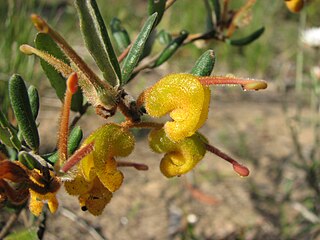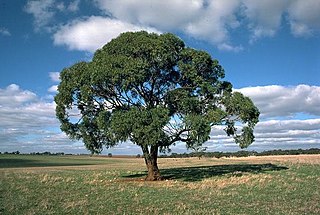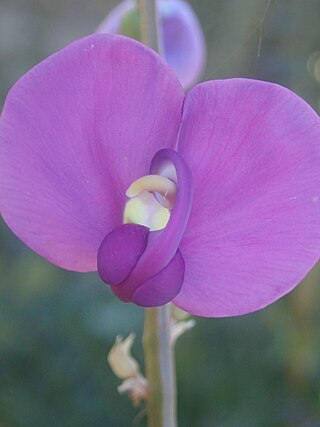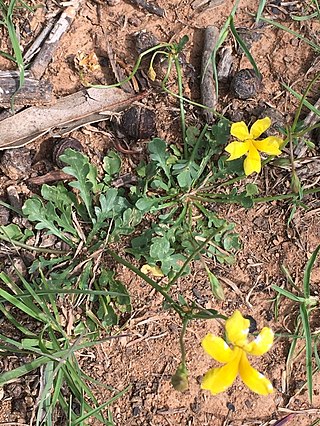
Banksia ornata, commonly known as desert banksia, is a species of shrub that is endemic to south-eastern continental Australia. The Ngarrindjeri people of the Lower Murray region in South Australia know it as yelakut. It has thin bark, serrated, narrow egg-shaped leaves with the lower end towards the base, cream-coloured flowers in a cylindrical spike, and later, up to fifty follicles in each spike, surrounded by the remains of the flowers.

Grevillea chrysophaea, commonly known as golden grevillea, is a species of flowering plant in the family Proteaceae and is endemic to Victoria in Australia. It is a spreading shrub with oblong to almost linear leaves, and dull to golden yellow flowers with a red or orange-red style.

Diuris behrii, commonly known as golden cowslips, is a species of orchid which is endemic to southern continental Australia. It has between three and six grass-like leaves and a flowering stem with up to four drooping, yellow flowers with dark streaks on the labellum. The flowers appear between September and November in its native range.

Eucalyptus odorata, commonly known as peppermint box, is a species of mallee or a small tree that is endemic to South Australia. It has rough, hard bark on the trunk and larger branches, smooth greyish bark on the thinner branches, lance-shaped adult leaves, flower buds in groups of between seven and eleven, white flowers and cylindrical or barrel-shaped fruit.

Gaudium myrsinoides, commonly known as the heath tea-tree or silky tea-tree, is a species of shrub that is endemic to south-eastern continental Australia. It has smooth bark on the younger stems, narrow egg-shaped leaves with the narrower end towards the base, white flowers and fruit that has the remains of the sepals attached but usually falls from the plant soon after the seeds are released.

Prostanthera striatiflora, commonly known as jockey's cap, striated mintbush or striped mintbush, is a species of flowering plant that is endemic to the more arid areas of Australia. It is an erect, aromatic shrub with narrow egg-shaped to narrow elliptic leaves and white flowers with purple lines inside the petal tube.

Goodenia albiflora, commonly known as white goodenia, is a species of flowering plant in the family Goodeniaceae and endemic to South Australia. It is a small, erect shrub with ridged stems, elliptic to egg-shaped, cauline leaves, racemes of white flowers with leaf-like bracteoles at the base, and oval fruit.
Caladenia behrii, commonly known as pink-lipped spider orchid, is a plant in the orchid family Orchidaceae and is endemic to South Australia. It has a single narrow, hairy leaf and one or two creamy-white flowers with pink tips in early spring.

Caladenia tentaculata, commonly known as the eastern mantis orchid, large green-comb, green comb or fringed spider orchid is a plant in the orchid family Orchidaceae and is endemic to south-eastern Australia. It is a ground orchid with a single, hairy leaf and up to three green flowers with red stripes on the sepals and petals.

Swainsona procumbens, commonly known as Broughton pea or swamp pea is a species of flowering plant in the pea family (Fabaceae), and is native to Australia. It is a spreading or ascending perennial shrub-like herb with imparipinnate leaves with 15 to 25 linear to narrowly lance-shaped leaflets with the narrower end towards the base, and racemes of 2 to 12 purple or mauve to pink flowers.

Prostanthera behriana, commonly known as tall mintbush, is a species of flowering plant in the family Lamiaceae and is endemic to the south-east of South Australia. It is an erect to straggling shrub with egg-shaped leaves and white, pale blue, pale violet or purplish white flowers with red-brown spots or purple streaks inside.

Goodenia calcarata, commonly known as streaked goodenia, is a species of flowering plant in the family Goodeniaceae and is endemic to Australia. It is an erect, annual herb with toothed egg-shaped to oblong leaves, racemes of white, cream-coloured or pink to mauve flowers with brownish markings, and oval fruit.

Goodenia pinnatifida, commonly known as cut-leaf goodenia, scrambled eggs or mother ducks, is a species of flowering plant in the family Goodeniaceae and endemic to Australia. It is a low-lying to ascending perennial herb with toothed to pinnatisect leaves, racemes of yellow flowers and more or less spherical fruit.

Dampiera rosmarinifolia, commonly known as rosemary dampiera, is a flowering plant in the family Goodeniaceae.It is a perennial subshrub with linear leaves, mauve or purple flowers borne in leaf axils.

Olearia muelleri, commonly known as Mueller daisy bush, Mueller's daisy bush or Goldfields daisy, is a species of flowering plant in the family Asteraceae and is endemic to southern continental Australia. It is a compact or spreading shrub with scattered spatula-shaped to egg-shaped leaves with the narrower end towards the base, and white and yellow, daisy-like inflorescences.
Pomaderris flabellaris, commonly known as fan pomaderris, is a species of flowering plant in the family Rhamnaceae and is endemic to South Australia. It is a low shrub with fan-shaped leaves, and small clusters of woolly-hairy flowers.

Pomaderris helianthemifolia is a species of flowering plant in the family Rhamnaceae and is endemic to south-eastern continental Australia. It is a bushy shrub with hairy young stems, narrowly elliptic to lance-shaped leaves with the narrower end towards the base, and small panicles of hairy yellowish flowers.

Olearia brachyphylla is a species of flowering plant in the family Asteraceae and is endemic to southern continental Australia. It is a densely-branched, aromatic shrub with woolly-hairy stems, oblong to egg-shaped leaves with the narrower end towards the base and small white and pale yellow, daisy-like inflorescences.

Brachyloma ericoides is a species of flowering plant in the family Ericaceae and is endemic to the south-east of continental Australia. It is an erect or spreading shrub with linear to narrowly elliptic leaves and usually pink, tube-shaped flowers.

Abutilon halophilum is a flowering plant in the family Malvaceae. It is a small understory shrub with yellow or cream-white flowers and hairy oval-shaped leaves and grows in New South Wales, South Australia and the Northern Territory.



















